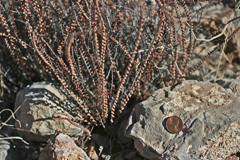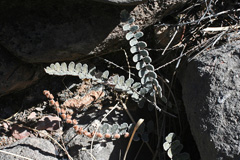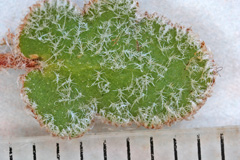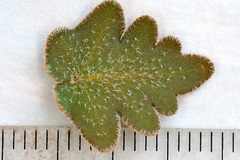| | | |
| | | | | |
1. Longest pinnae very small, usually about 5mm and no longer than 7mm in length; adaxial (topside) scales are broad like a shield with
cilia coming off the edges.....Astrolepis cochisensis. | |
1. Longest pinnae longer than 7mm, adaxial scales attached at the end and elongate .....2. | |
| 2. Largest pinnae asymmetrically lobed or nearly entire, adaxial scales so dense
that the adaxial surface looks bluish gray, most fronds less than 25cm tall.....Astrolepis integerrima. |
| 2. Largest pinnae are symmetrically lobed, apparent color of pinnae not influenced by the scales, fronds
frequently over 25cm tall.....3. |
| 3. Pinnae very shallowly lobed, so as to appear nearly entire; adaxial scales deciduous and sparse, but those
remaining are 2-4 times as thick as the cilia.....Astrolepis windhamii. |
| 3. Pinnae noticably lobed, sometimes markedly; the few adaxial scales that remain on mature fronds are about as thick as the cilia.....Astrolepis sinuata. |







